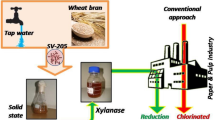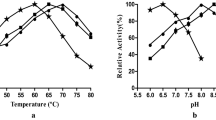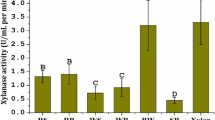Abstract
Mixed enzyme preparation having both xylanase and laccase activity was evaluated for its bleach enhancing ability of mixed wood pulp. The enzyme was produced through co-cultivation of mutant Penicillium oxalicum SAUE-3.510 and Pleurotus ostreatus MTCC 1804 under solid-state fermentation. Bleaching of pulp with mixed enzyme had resulted into a notable decrease in kappa number and increased brightness as compared to xylanase alone. Analysis of bleaching conditions had denoted that 8 IU g−1 of mixed enzyme preparation (xylanase/laccase, 22:1) had led into maximal removal of lignin from pulp when bleaching was performed at 10% pulp consistency (55 °C, pH 9.0) for 3 h. An overall improvement of 21%, 8%, 3%, and 5% respectively in kappa number, brightness, yellowness, and viscosity of pulp was achieved under derived bleaching conditions. Process of enzymatic bleaching was further ascertained by analyzing the changes occurring in polysaccharide and lignin by HPLC and FTIR. The UV absorption spectrum of the compounds released during enzymatic treatment had denoted a characteristic peak at 280 nm, indicating the presence of lignin in released coloring matter. The changes in fiber morphology following enzymatic delignification were studied by scanning electron microscopy.








Similar content being viewed by others
References
Barreca, A. M., Fabbrini, M., Galli, C., Gentili, P., & Ljunggren, S. (2003). Laccase/mediated oxidation of a lignin model for improved delignification procedures. Journal of Molecular Catalysis B, Enzymatic, 26, 105–110. doi:10.1016/j.molcatb.2003.08.001.
Uffen, R. L. (1997). Xylan degradation: a glimpse at Microbiol diversity. Journal of Industrial Microbiology & Biotechnology, 19, 1–6. doi:10.1038/sj.jim.2900417.
Record, E., Asther, M., Sigoillot, C., Pages, S., Punt, P. J., Haon, M., et al. (2003). Overproduction of the Aspergillus niger feruloyl esterase for pulp bleaching applications. Applied Microbiology and Biotechnology, 62, 349–355. doi:10.1007/s00253-003-1325-4.
Bajpai, P., & Bajpai, P. K. (1992). Biobleaching of kraft pulp. Proc Biochem, 27, 319–325. doi:10.1016/0032-9592(92)87009-6.
Ragauskus, A. J., Poll, K. N., & Cesternino, A. (1994). Effects of xylanase pretreatment procedures on non-chlorine bleaching. Enzyme and Microbial Technology, 16, 492–495. doi:10.1016/0141-0229(94)90019-1.
Tolan, J. S., & Guenette, M. (1997). Using enzymes in pulp bleaching: mill applications. Advances in Biochemical Engineering/Biotechnology, 157, 290–309.
Paice, M. G., Gurnagul, N., Page, D. H., & Jurasek, L. (1992). Mechanism of hemicellulose directed prebleaching of kraft pulp. Enzyme & Microbial Technology, 14, 272–276. doi:10.1016/0141-0229(92)90150-M.
Pham, P. L., Alric, I., & Delmas, M. (1995). Incorporation of xylanase in total chlorine free bleach sequences using ozone and hydrogen peroxide. Appita Journal, 48, 213–217.
Niku-Paavola, M. L., Ranua, M., Suurnakki, A., & Kantelinen, A. (1994). Effects of lignin modifying enzymes on pine kraft pulp. Bioresource Technology, 50, 73–77. doi:10.1016/0960-8524(94)90223-2.
Garg, A. P., Roberts, J. C., & Mc Carthy, A. J. (1998). Bleach boosting effect of cellulase free xylanase of Streptomyces thermoviolaceus and its comparison with two commercial enzyme prepartions on birchwood kraft pulp. Enzyme and Microbial Technology, 22, 594–598. doi:10.1016/S0141-0229(97)00250-0.
Beg, Q. K., Bhushan, B., Kapoor, M., & Hoondal, G. S. (2000). Production and characterization of thermostable xylanase and pectinase from a Streptomyces sp. QG-11–3. Journal of Industrial Microbiology & Biotechnology, 16, 211–213.
Atik, C., Imamoglu, S., & Bermek, H. (2006). Impact of xylanase pre-treatment on peroxide bleaching stage of biokraft pulp. International Biodeterioration & Biodegradation, 58, 22–26. doi:10.1016/j.ibiod.2006.04.003.
Sandrim, V. C., Rizzatti, A. C. S., Terenzi, H. F., Jorge, J. A., Milagres, A. M. F., & Polizeli, M. L. T. M. (2005). Purification and biochemical characterization of two xylanases produced by Aspergillus caespitosus and their potential for kraft pulp bleaching. Process Biochemistry, 40, 1823–1828. doi:10.1016/j.procbio.2004.06.061.
Khandeparkar, R., & Bhosle, N. B. (2007). Application of thermoalkalophilic xylanase from Arthrobacter sp. MTCC 5214 in biobleaching of kraft pulp. Bioresource Technology, 98, 897–903. doi:10.1016/j.biortech.2006.02.037.
Medeiros, R. G., Silva, F. G., Jr., Salles, B. C., Estelles, R. S., & Filho, E. X. F. (2002). The performance of fungal xylan-degrading enzyme preparations in elemental chlorine free bleaching for eucalyptus pulp. Journal of Industrial Microbiology & Biotechnology, 28, 204–206. doi:10.1038/sj.jim.7000227.
Roncero, M. B., Torres, A. L., Colom, J. F., & Vidal, T. (2003). TCF bleaching of wheat straw pulp using ozone and xylanase. Part A: paper quality assessment. Bioresource Technology, 87, 305–314. doi:10.1016/S0960-8524(02)00224-9.
Gronqvist, S., Buchert, J., Rantanen, K., Viikari, L., & Suurnakki, A. (2003). Activity of laccase on unbleached and bleached thermomechanical pulp. Enzyme & Microbial Technology, 32, 439–445. doi:10.1016/S0141-0229(02)00319-8.
Lund, M., Eriksson, M., & Felby, C. (2003). Reactivity of fungal laccase towards lignin in softwood kraft pulp. Holzforschung, 57, 21–26. doi:10.1515/HF.2003.004.
Camarero, S., Ibarra, D., Martinez, A. T., Romero, J., Gutlerrez, A., & Rio, J. C. D. (2007). Paper pulp delignification using laccase and natural mediators. Enzyme & Microbial Technology, 40, 1264–1271. doi:10.1016/j.enzmictec.2006.09.016.
Ibarra, D., Romero, J., Martinez, M. J., Martinez, A. T., & Camarero, S. (2006). Exploring the enzymatic parameters for optimal delignification of eucalyptus pulp by laccase mediator. Enzyme & Microbial Technology, 39, 1319–1327. doi:10.1016/j.enzmictec.2006.03.019.
Miller, G. L. (1959). Use of dinitrosalicylic acid reagent for determination of reducing sugar. Analytical Chemistry, 31, 426–428. doi:10.1021/ac60147a030.
de-Souza Cruz, P. B., Freer, J., Siika-aho, M., & Ferraz, A. (2004). Extraction and determination of enzyme produced by Cerriporiopsis subvermispora during biopulping of Pinus Taeda wood chips. Enzyme & Microbial Technology, 34, 228–234.
Patel, A. N., Grabski, A. C., & Jeffries, T. W. (1993). Chromophore release from kraft pulp by purified Streptomyces roseiscleroticus xylanase. Applied Microbiology & Biotechnology, 39, 405–412. doi:10.1007/BF00192102.
Gupta, S., Bhushan, B., & Hoondal, G. S. (2000). Isolation, purification and characterization of xylanase from Staphylococcus sp. SG-13 and its application in biobleaching of kraft pulp. Journal of Applied Microbiology, 88, 325–334. doi:10.1046/j.1365-2672.2000.00974.x.
TAPPI test methods. (1996). Technical association of the pulp and paper industry. Atlanta, GA: TAPPI press.
Geng, X., & Li, K. (2002). Degradation of nonphenolic lignin by the white-rot fungus Pycnoporus cinnabarinus. Applied Microbiology & Biotechnology, 60, 342–346. doi:10.1007/s00253-002-1124-3.
Buta, J. G., Zardrazil, F., & Gallettti, G. C. (1989). FT-IR determination of lignin degradation in wheat straw by white rot fungus Stropharia rugosoannulata with different oxygen concentrations. Journal of Agricultural & Food Chemistry, 37, 1382–1384. doi:10.1021/jf00089a038.
Niku-Paavola, M. L., Karhunen, E., Salola, P., & Raunio, V. (1988). Lignolytic enzymes of the white rot fungus Phlebia radiata. Journal of Biochemistry, 266, 36–43.
Goodell, B., Yamamoto, K., Jellison, J., Nakamura, M., Fujii, T., Takabe, K., et al. (1998). Laccase immunolabelling and microanalytical analysis of wood degraded by Lentinus edodes. Holzforschung, 52, 345–350.
Torres, A. L., Roncero, M. B., Colom, J. F., Pastor, F. I. J., Blanco, A., & Vidal, T. (2000). Effect of a novel enzyme on fibre morphology during ECF bleaching of oxygen delignified eucalyptus kraft pulps. Bioresource Technology, 74, 135–140. doi:10.1016/S0960-8524(99)00178-9.
Roncero, M. B., Torres, A. L., Colom, J. F., & Vidal, T. (2000). Using xylanase before oxygen delignification on TCF bleaching. Influence on fiber surfaces by SEM. Process Biochemistry, 36, 45–50. doi:10.1016/S0032-9592(00)00178-3.
Roncero, M. B., Torres, A. L., Colom, J. F., & Vidal, T. (2005). The effect of xylanase on lignocellulosic components during the bleaching of wood pulps. Bioresource Technology, 96, 21–30. doi:10.1016/j.biortech.2004.03.003.
Sealey, J., & Ragaukas, A. J. (1998). Residual lignin studies of laccase-delignified kraft pulps. Enzyme & Microbial Technology, 23, 422–426. doi:10.1016/S0141-0229(98)00056-8.
El Mansouri, N. E., & Salvado, J. (2007). Analytical methods for determining functional groups in various technical lignins. Industrial Crops & Products, 26, 116–124. doi:10.1016/j.indcrop. 2007.02.006.
Faix, O. (1992). Methods in lignin chemistry, Fourier transform infrared spectroscopy (Lin, S. Y., & Dence, C. W., ed.) (pp. 83–109). Berlin, Heidelberg: Springer.
Acknowledgements
Senior research fellowship awarded by Council of Scientific and Industrial Research, New Delhi, India to first author and national doctoral fellowship to second author by All India Council of Technical Education, New Delhi, India are gratefully acknowledged.
Author information
Authors and Affiliations
Corresponding author
Rights and permissions
About this article
Cite this article
Dwivedi, P., Vivekanand, V., Pareek, N. et al. Bleach Enhancement of Mixed Wood Pulp by Xylanase–Laccase Concoction Derived Through Co-culture Strategy. Appl Biochem Biotechnol 160, 255–268 (2010). https://doi.org/10.1007/s12010-009-8654-4
Received:
Accepted:
Published:
Issue Date:
DOI: https://doi.org/10.1007/s12010-009-8654-4




